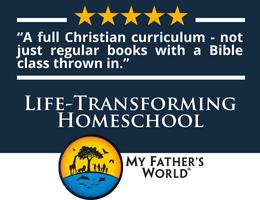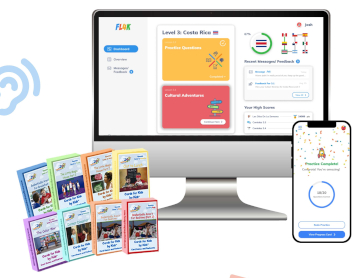Foreign Languages for Kids (FL4K) makes excellent use of technology in the new version of their program, now available as FL4K Spanish. I don’t know of any other online Spanish program for homeschoolers that has as much variety. It uses a conversational approach, with continuous practice and review in listening, reading, speaking, and writing along with some offline activities.
There's a fun exploratory or discovery program for kindergarten through second grade, and comprehensive programs for grades three through nine. The exploratory program for pre-readers focuses on listening and speaking and does not require reading and writing. The first level of the exploratory program is available, and a second level is planned for release in the fall of 2023.
The program for grades three through nine has more than 500 online lessons presented in nine levels. It offers several pacing options to suit students working at various levels. Parents who want children working offline part of the time might choose a bundle that includes printed workbooks along with an online subscription, or a bundle that provides even more hands-on/offline work with workbooks, teacher guides, card decks, stickers, and a stuffed animal along with an online subscription.
Annual subscriptions allow parents to set and change levels: red for children in prekindergarten through second grade, yellow for grades three through five, and green for grades six through nine (or ten).
High school students completing the entire program should have reached a level equivalent to or beyond the completion of Spanish 1. Because of its conversational approach, students learn less formal grammar, but they are probably going to be able to carry on conversations, which is more than can be said for most first-year high school Spanish programs.
FL4K Spanish includes the following: video lessons; FL4K Cultural Adventures (geography and culture lessons); online games for developing language proficiency; interactive dialogs and questions in many different formats for speaking practice, listening, reading, and writing; online quizzes; and songs.
Students need a mic as well as speakers or a headset for these activities. For example, there are activities where students see an image and hear a line of dialogue, then choose between two audio responses. After they identify the correct response, they are prompted to say and record that response themselves. Students can then listen to the complete dialogue that inserts their responses into the prerecorded part.
There are 15 different formats for questions for blue and green levels, such as interacting with clips from the videos, responding by identifying which of two auditory responses makes sense, identifying the correct image, and typing in vocabulary words—special Spanish characters for typing are available to the student. Responses other than those recorded by the program are evaluated immediately, and students can try again if they miss something.
The games—Bounce and Fly Swatter—require students to identify images or words that change to reflect current and prior lesson material. Both games move quickly, so students need to be practicing their vocabulary to be able to complete a game successfully.
The four-minute “FL4K Activities Demo” gives you an excellent introduction to many of the program's features.
Videos
Videos serve as the primary source of language instruction. FL4K videos were filmed with multiple cameras in colorful settings and they include lively background music. Videos are introduced with a flight theme that pops up from time to time. The videos of interconnected skits feature child actors of various ages up into the teens.
All conversations are in Spanish, although they use fairly simple vocabulary most of the time. In the video segments for the first level, students learn basic conversational vocabulary such as hola, gracias, donde esta? (where is it?), words related to breakfast, pelotas (balls), and grande y pequeño (large and small). The next level’s words relate to lunch, colors, and other frequently used words. For example, in the “The Wacky Rainbow Restaurant” the children argue about whether they like leche verde (green milk) using me gusta (I like).
The skits are orchestrated to emphasize particular words or phrases, sometimes repeating the same vocabulary in several different contexts. For example, to teach children how to relate their age, one child interviews many different children to ask them their ages. Children respond with various phrases so that those watching learn not just one simple response but a few possible responses. Words are often overlaid on the videos so that children who are able to read can see how the words are spelled. Children in the videos speak more slowly than normal Spanish speakers, so it is generally easy to make out what they are saying.
The videos are presented in segments that are repeated, and there is an option for students to watch straight through the entire video for each level. Some segments conclude with what FL4K calls a “Rapid Visual Review” of the vocabulary introduced in that segment.
Culture and Geography Lessons
The FL4K Cultural Adventure lessons feature different Spanish-speaking countries. The lessons address geography, climate, and present-day culture, including some issues with social impact, such as climate change and migration.
The lessons use images or brief videos with written content and questions. Some questions test comprehension of the material. Many questions are presented as “comments” since they ask students for personal opinions or about their own experiences. If parents wish, the comments can be shared with others in their own family or group.
Parents can choose settings that display the written content in either English with some words in Spanish (gradually increasing the number of Spanish words) or completely in Spanish.
Much additional vocabulary is introduced in the Cultural Adventure lessons, so they are an important component.
Printable Resources, Cards, and Games
Printable resources for offline activities are included for both blue and green levels. Among them are pre-written conversations to practice, song lyrics, worksheets with written activities, games, scoring rubrics for student presentations, a passport activity, and cooking activities.
Optional items might also be of interest.
Cards for Kids by Kids™ for each level provide vocabulary words and phrases and corresponding picture cards that use images from the videos. Familiarity with the videos is essential since students sometimes need to recall the personalities and actions of the children in the videos to know what word or phrase is being depicted. The deck for each level can be used for several different games as described in the instructions, or they can be used simply as flashcards. As students move from one level to another, using the accumulated flashcards from previous levels is an excellent way to review.
Sets of vocabulary-word stickers for each level should be great visual teaching tools for children who can read the words. Children (or adults) can place the stickers on objects around the house to reinforce the vocabulary. Stickers are at least 1.5 inches high and generally from 2.5 to 3.5 inches wide with large lettering, so they are easy to see. Sets of encouragement stickers are also available.
¡Listo! Is a bingo game that can be used along with the first three levels of FL4K.
The Dice Off™ game for students ages seven and up adds another layer of reinforcement that most students are likely to enjoy. Even adults who are learning Spanish might play this game. The game has four individual game boards (for two to four players), each featuring different verbs and adverbs for players to say and act out. “Gotcha” and “Faker-Mistaker” cards make play more complex—what happens on one player’s turn can affect the advancement of other players.
The optional teacher guides make it easy for parents to incorporate these other resources. The guides were created for the original version of FL4K and lay out detailed lesson plans that include the videos, workbook pages, and suggested hands-on activities from the original program. Much of that is already laid out in the online program, but the guides let parents know when they might use the games, cards, stickers, and other interactions. Parents who don’t speak Spanish should also appreciate the vocabulary lists for easy reference. However, teacher guides are not required.
An optional “Digital Set” consists of the teacher’s guides and card games at reduced prices. You can also purchase a bundle with the card sets and the two games. For non-readers, you might be interested in the supplement set that includes stuffed animals, a coloring book, stickers, and the ¡Listo! game.
Parents
Parents have their own dashboard with access to detailed student progress reports. While much of FL4K Spanish is presented online, the program still requires some parental oversight for younger students. Upper elementary and middle-school students should be able to work with minimal oversight. However, parents should also try to practice Spanish conversations with their children, learning along with their children if possible.
The Welcome page should be the starting place for parents since it explains how the program works, offline activities, and other important topics. Because the program has so many features, this information is essential for knowing what is available.
Parents can choose the way the program presents the Cultural Adventures under the Overview tab. They can choose either the blue or green level and either English or Simple Spanish as the primary language of presentation. The green level also offers a “Heritage Culture” option for students coming from a Hispanic culture who can speak Spanish but might need work on reading and writing.
Parents can assign particular activities to students if they wish, but it is fine to let them work independently straight through all the activities.
In the past, parents needed to evaluate students’ recorded oral responses, but a new option also allows students to self-evaluate. With either option, both audio and text answers are available for the evaluator. If parents are evaluating, they can send the student a written or oral comment via the program’s messaging feature. Providing oral practice is the biggest challenge for programs such as this because voice recognition software is usually not good at evaluating children’s responses when they are just learning a new language. So giving parents and students the tools to evaluate oral responses seems a very practical way to solve that problem.
Summary
FL4K Spanish is a major improvement over the original program, which was already excellent. This program has far more content than the original, and more is still being added. The variety of activities and modes of learning makes it likely to work for most students, and the wealth of resources within the program allows parents to adapt it or expand it with additional activities.








